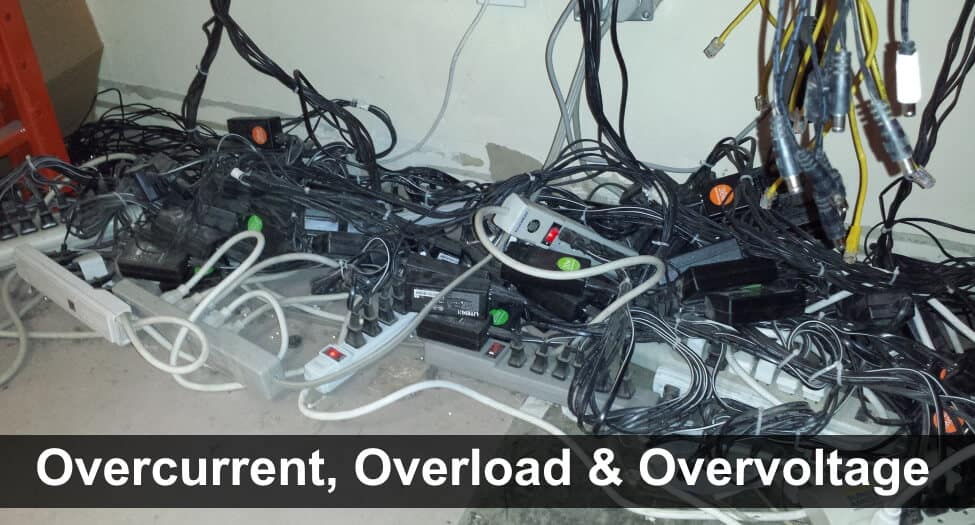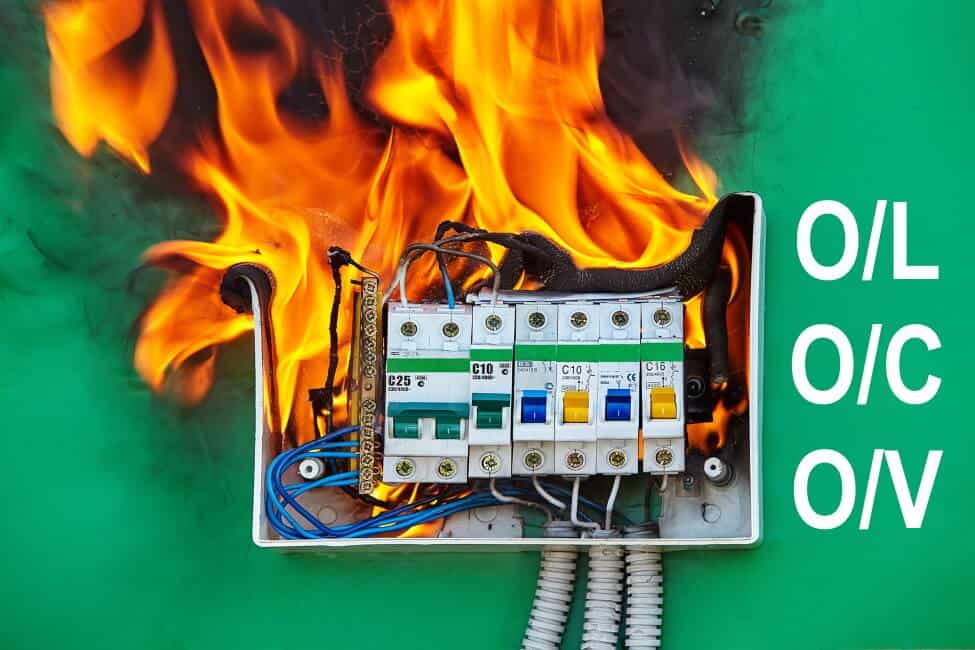Difference Between Overcurrent, Overload and Overvoltage
Main Difference Between Overload, Overcurrent and Overvoltage
Newbies and freshers must clear the basic concepts due to the confusing terms used in the electrical and electronics engineering theories and studies such as short circuit, overcurrent, overvoltage and overload etc.
These terms and expression having likely meaning but different characteristics such as overload and short circuit, overvoltage and high-voltage etc. Now, let’s see that what the differences between overload, overvoltage and overcurrent are.
What is Overcurrent?
Overcurrent is the condition where excessive current starts to flow in the circuit due to overload and especially short circuit.
In case of short circuit, a very high current starts to flow in the circuit where the voltage level becomes almost zero across the load terminals which leads to the insulation failure, fire, damage the equipment and power system even serious and hazardous explosion.
For instance, a 125A circuit breaker tripping point (magnetic trip) rated for 200% is connected to a 100A load circuit. When the load current increase and reach the limit of 125A, it will trip eventually. If the current increase up to 200A, the breaker will operate instantly and protect the circuit from overcurrent due to short circuit etc.
Overcurrent Protection:
Overcurrent protection is generally a protection against short circuit where excessive current starts to flow in the circuit which leads to damage the connected equipment.
Fuses, circuit breakers, overcurrent relays, current limiters, temperature sensors and solid state power switches are used against overcurrent protection devices. In addition, a thermal magnetic circuit breaker is used for both overcurrent and overload protection.
What is Overload?
An electrical overload is the condition where the load takes more current than the normal or rated current.
For example, a #12 gauge wire can safely carry 20 amperes current. The circuit can be protected by minimum of 20A or 125% of load amperage i.e. (20A of load current x 125% = 25A). In this case, we must use maximum of 25A circuit breaker for protection. Now if we use 30A – 35A circuit breaker instead of the rated CB, it means the circuit breaker will allow about 30 to 35 amperes current to the load circuit which flows in the wires rated for 20A. In other words, the circuit breaker may allow more current than the nominal current which can only handle up to 20A. In this case, the wires may heats up and caught fire or damage the circuit and connected appliances while the breaker won’t trip as we didn’t use the proper size and rating of circuit breaker for protection.
Another example of overload is connecting a 1.5kW load to the 1kW alternator, inverter or transformer etc or when up to 1.5 times higher current flows through the circuit rather than the rated current.
Overload is the overcurrent flow in the circuit which causes overheating in the connected device hence, overload is a type of overcurrent.
Overload Protection:
Overload protection is actually a protection against overheat due to the flow of overcurrent in the circuit for specific time.
Slow blow fuses and overload relays are used against overload protection whereas, thermal magnetic circuit breaker are used for both overcurrent and overload protection. The “magnetic” element provides protection against overcurrent and “thermal” element protects the circuit from “overload” where it operate on inverse time curve i.e. the tripping time becomes less when current increases.
Typically, overload protection circuit activated when 120% – 160% greater current starts to flow in the circuit than the rated current by power supply.
What is Overvoltage?
Overvoltage is the condition where the operating or supply voltage is higher than the rated voltage of the system specified by the manufacturer.
As the name suggests, overvoltage is the higher supply voltage to a device than its nominal rated voltage. In short, voltage higher than the permissible voltage is known as overvoltage.
Generally, when the supply voltage increases up to 1.1 (which is 110%) of the rated voltage of a device is known the overvoltage unless specified by the manufactures.
For instance, if the rated voltage printed on the nameplate data rating of a machine is 230V AC ±10%. Now, If the supply voltages increase up to 250V+, the system becomes unstable due to overvoltage (iron losses) which leads to excessive heat and may damage the device and equipment.
Overvoltage Protection:
overvoltage caused by lightning strikes, power system and switching surges and insulation failure etc can be protected by avalanche diodes, voltage dependent resistors (VDR), gas discharge valves, lightning rods, arcing horns etc.
Generally, zener diode based electronic circuit are mostly used for small level overlarge protection. An overvoltage protection circuit will operate when the supply voltage increases up to 110% to 130% above the rated voltage of a device. This way, it will cut off the power supply to protect the device from overvoltage which may cause to damage the connected device.
Related Posts:
- Difference between AC Drives and DC Drives
- Difference between Lightning Arrester and Surge Arrester
- Difference Between Electric Current and Electric Charge
- Difference Between Microprocessor and Microcontroller
- Difference between Analog and Digital Multimeter
- Difference between Analog and Digital Multimeter
- Difference Between Electric and Magnetic Circuit
- Difference Between EMF and MMF
- Difference Between Active and Reactive Power – Watts vs VA
- Difference Between Relay and Circuit Breaker
- Difference Between a Battery and a Capacitor
- Difference Between Capacitor and Supercapacitor









How many watts are in one unit
I would love this technology but what about vedio as well linked ?to make it easy for learners
Elecrical wirings for domestic, commercial & industrial.
Please add each topic with easy to understandable example’s, I hope you will consider my suggestion for easy to learn and understand what you are trying to tell your readers.
Thanks
Good
Your explanation is a nice one I suggest you should have an e learning class were your registered customer can ask professional Questions and get results in a particular project.
Nice information